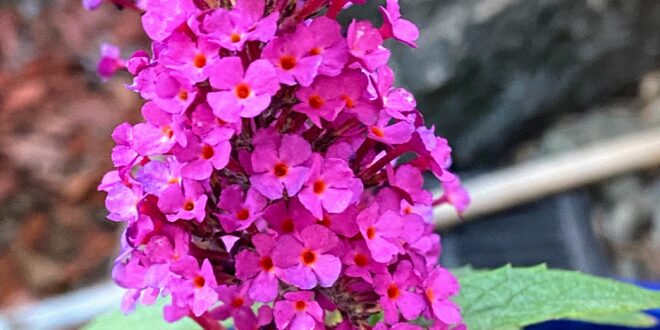This latest in the Buzz series of compact butterfly bushes features vivid fuchsia-pink flowers on 10” long arching cones. Blooming from early summer to late fall, the sweetly scented flowers are a magnet for bees, butterflies & hummingbirds. Once established, plants are covered in vibrant swathes of hot raspberry flowers. This award winner is definitely meant to be a focal point in your garden! Its compactness (3-4′ H&W) means that it is easily grown in a container, while its spread means it can hold its own in a garden bed. Use wherever you wish to make a bold statement or to anchor a pollinator garden. Flower cones make a wonderful cut flower. Very drought tolerant once established. Deadhead to prolong blooming. Plant in full sun in fertile, well-drained soil. Prune to desired shape. Deer resistant.
Culture
Easily grown in average, medium moisture, well-drained soils in full sun. Becomes weedy and sparse with diminished flowering performance if not grown in full sun. Does poorly in wet, poorly draining conditions. Will adapt to clay soil if properly amended. Even if plants do not die to the ground in winter, they often grow more vigorously, produce superior flowers and maintain better shape if cut close to the ground in late winter each year. Prompt removal of spent flower spikes during the growing season will usually encourage continued bloom until frost. This shrub will naturalize, sometimes aggressively, by self-seeding (seed dispersed by wind), particularly in areas where it does not die back in winter. Where self-seeding is a potential problem, remove spent flower clusters prior to formation/disbursement of seed.
Noteworthy Characteristics
The native form of this plant (not this variety) has been declared a noxious weed in Oregon and Washington. Aggressive spreading has been observed in a number of eastern states including Pennsylvania, New Jersey, West Virginia, Kentucky and North Carolina.
Spike-like terminal and axillary flower clusters bloom from early to late summer, sometimes to first frost. Flowers are densely clustered in showy cone-shaped panicles from 6-18” long. In the wild, straight species flowers are lilac to purple with orange-yellow throats. Numerous named cultivars have been introduced over the years, expanding the range of flower colors to include pinks, yellows, whites and reds. Flowers (each to ½” long) are mildly fragrant, and, as the common name suggests, very attractive to butterflies. Flowers are also very attractive to hummingbirds and bees. Flowers give way to two-valved seed capsules that split open when ripe (about 50 seeds per capsule). Finely toothed, elliptic to lanceolate leaves (6-10” long) taper to long points. Leaves are sage green above and white tomentose beneath.
Genus name honors the Reverend Adam Buddle (1660-1715), English botanist and vicar of Farmbridge in Essex.
The genus name is frequently listed today as Buddleia. However, Linnaeus named the genus Buddleja (pronounced with a silent “j”) which is still considered to be the proper spelling (first name survives) according to the International Code of Botanical Nomenclature.
Specific epithet honors Pere Armand David (1826-1900), French missionary and naturalist, who found this species growing in China in 1869/1870 along the border of China and Tibet.
Common name refers to the plant being very attractive to butterflies.
‘Black Knight’ is a butterfly bush cultivar which features almost black flowers. It is a deciduous shrub with an arching, spreading habit which typically grows 6-8′ tall if not cut back in late winter and 4-5′ tall if cut back. Features spike-like 4-10″ long terminal clusters of very dark purple flowers which bloom from June to September and sometimes to first frost. Flowers are fragrant.
Problems
No serious insect or disease problems. Watch for spider mites. Nematodes can be troublesome in the South.
Uses
Provides excellent summer to fall flowers when few other shrubs are in bloom. Best grown in borders, cottage gardens, rose gardens or butterfly gardens. Foundations. Popular fresh cut flower.
- Common Name: butterfly bush
- Type: Deciduous shrub
- Family: Scrophulariaceae
- Zone: 5 to 9
- Height: 3.00 to 4.00 feet
- Spread: 3.00 to 4.00 feet
- Bloom Time: June to September
- Bloom Description: Very dark purple
- Sun: Full sun
- Water: Medium
- Maintenance: Low
- Flower: Showy, Fragrant, Good Cut
- Attracts: Butterflies
- Tolerate: Rabbit, Clay Soil








